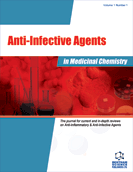Abstract
The purpose of this contribution is to introduce the bananins or trioxa-adamantane-triols (TATs), a newly discovered class of anti-RNA-coronaviral agents which are active against human severe acute respiratory syndrome (SARS) coronavirus (SARS-CoV). The prototype compound bananin inhibited replication of SARS-CoV, probably through inhibition of SARS-CoV nsp13 ATPase/NTPase DNA/RNA helicase protein enzymatic function(s). Up-to-date eleven bananins [BN, IBNCA, ABNCA, ansaBN, euBN, VANBA, ethylVANBA, euVANBA, Ehrlich BN, [6]prismaneBN, nitrodiBN] were produced, four of which (BN, IBNCA, euBN, VANBA) inhibited both SARS-CoV replicase 1b protein nsp13 ATPase and DNA helicase enzymatic activity in vitro. The unique cage structure of the TATs was proofed by NMR spectroscopy, IR spectroscopy, and UV/VIS spectrophotometry. Some modern two-dimensional NMR techniques (HHCOSY, gs-HMBC, gs-HSQC) and high resolution electrospray mass spectrometry (HR-ESI MS) were used to investigate the more complex bananins like [6]prismaneBN. The latter compound was reacted with all-trans-retinoic acid (ATRA) to yield the 12th TAT [6]prismaneBN-ATRA which served as tool for proofing the general bananin structure(s) by HR-ESI MS. The group of TATs includes compounds with very unusual structures [ansaBN, [6]prismaneBN, nitrodiBN, [6]prismaneBN-ATRA], achieved only by skillful combination of organic synthetic achievements. The triazahexaprismane derivative [6]prismaneBN, and the dinitrohexaprismane derivative nitrodiBN, are the first successfully synthesized true hexaprismane [[6]prismane] derivatives. Because of theoretical considerations the bananins bear a great future intrinsic potential to inhibit RNA-viral replication of various RNA viruses, especially of hepatitis C virus (Flaviviridae), avian flu (influenza virus H5N1, Orthomyxoviridae), Ebola and Marburg virus (Filoviridae), Nipah and Hendra virus (Paramyxoviridae), Hantaan virus (Bunyaviridae), Lassa virus (Arenaviridae), yellow fever virus and dengue virus (Flaviviridae), tick-borne encephalitis virus (FSME virus, Flaviviridae), rabies virus (Rhabdoviridae), and, possibly, certain Picornaviridae (poliovirus, hepatitis A virus, coxsackievirus, echovirus, rhinovirus). Future work will be needed to define the true antiviral chemotherapeutic spectrum of the bananins which might in some way resemble the capacity of the first broad-spectrum virustatic drug ribavirin (1-beta-D-ribofuranosyl-1,2,4-triazole-3-carboxamide), but, as to be expected, without exhibiting the pronounced host cell toxicity of ribavirin.
Keywords: All-trans-Retinoic Acid (ATRA), cycloaddition, severe acute respiratory syndrome, polyzonimine, feline enteric coronavirus
 5
5





















